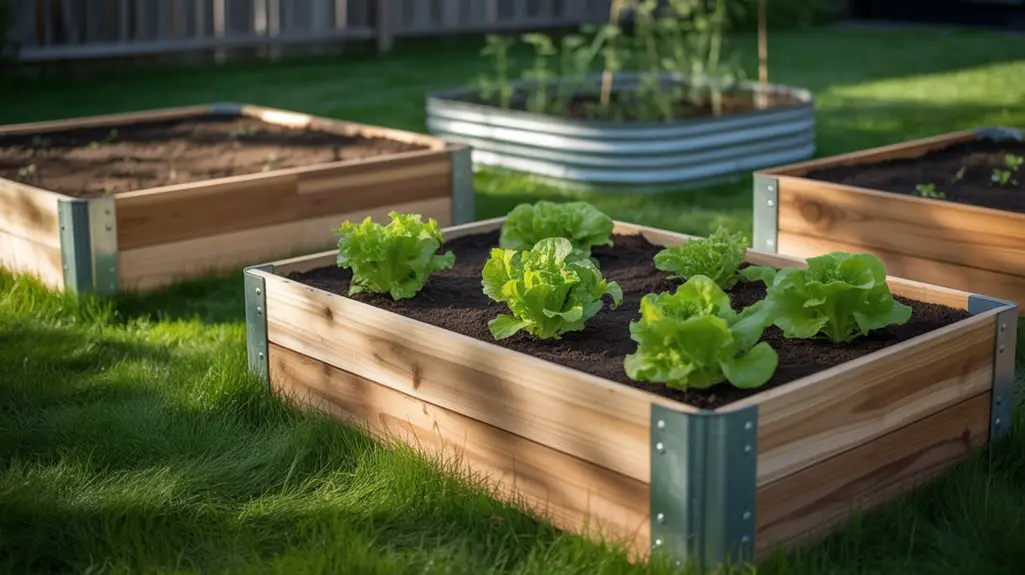Nearly 80% of homeowners use chemical pesticides that harm beneficial insects along with pests, disrupting critical backyard ecosystems. You’ll find these conventional methods not only damage pollinators but can leach into soil and water systems, potentially affecting your family’s health. By implementing strategic natural pest control techniques, you can maintain a thriving garden while preserving the delicate balance of helpful organisms. The right combination of preventative measures creates an effective defense system without introducing toxins to your outdoor space.
Understanding Common Backyard Pests and Their Natural Predators
Before implementing any pest control strategy, you must identify the common pests inhabiting your backyard and understand their natural enemies in the ecosystem.
Aphids, caterpillars, slugs, and various beetles typically comprise the primary garden threats, while spiders, ladybugs, praying mantises, and parasitic wasps serve as beneficial predators.
Observe pest patterns during different seasons; most insects emerge in spring and multiply throughout summer. Document damage patterns—leaf holes indicate beetles or caterpillars, while wilting may suggest sap-sucking insects like aphids.
Beneficial insects require specific habitats to thrive: flowering plants attract pollinators and predators, while ground cover provides shelter for beetles and spiders. Additionally, implementing effective natural insecticides can help manage pest populations without harming beneficial species.
Environmental regulations often restrict chemical interventions, making biological control methods preferable. Your regional agricultural extension office can provide location-specific pest identification resources compliant with local regulations.
Companion Planting: Strategic Vegetation to Deter Unwanted Insects

Companion planting strategically positions specific plant species together to naturally repel pest insects while enhancing overall garden health. This method leverages biochemical interactions between plants to create a protective environment that reduces the need for chemical pesticides.
Implementation requires understanding plant compatibility and pest deterrence mechanisms.
- Marigolds emit thiophene that repels nematodes and whiteflies when planted alongside tomatoes or peppers.
- Nasturtiums function as trap crops by attracting aphids away from valuable vegetables.
- Herbs such as basil, mint, and rosemary contain aromatic compounds that mask host-plant scents from pest detection systems.
Additionally, incorporating homemade pest repellents can further bolster your garden’s defenses against infestations.
When establishing companion plantings, maintain appropriate spacing to avoid competition for nutrients.
Document your garden layout annually to evaluate effectiveness and facilitate proper crop rotation, which further disrupts pest life cycles.
DIY Natural Sprays Using Kitchen Ingredients

Expanding beyond plant-based deterrents, homeowners can create effective pest management solutions using common kitchen ingredients. These formulations comply with organic gardening standards while minimizing exposure to synthetic chemicals. Additionally, employing sustainable pest management practices can enhance the overall health of your garden ecosystem.
Mix one tablespoon of neem oil with one teaspoon of mild liquid soap and one liter of water for a broad-spectrum insecticide.
For fungal issues, combine one part milk with nine parts water. A garlic-pepper spray (five crushed garlic cloves and one tablespoon of cayenne pepper steeped in water overnight) effectively repels aphids and beetles.
Always test sprays on small plant sections before widespread application. Apply during early morning or evening to prevent leaf burn.
Store solutions in labeled containers away from food preparation areas and use within one week for maximum efficacy.
Beneficial Insects: How to Attract Garden Allies
While chemical interventions often disrupt beneficial species, strategic garden design can establish a sustainable ecosystem populated with predatory insects that naturally control pest populations.
You’ll find that ladybugs, lacewings, and parasitic wasps effectively manage aphids, caterpillars, and other destructive pests when properly attracted to your garden.
To cultivate these beneficial relationships, implement these evidence-based strategies:
- Plant diverse nectar sources including sweet alyssum, dill, and flowering herbs to provide adult beneficial insects with essential energy resources.
- Maintain permanent mulch zones that offer shelter and overwintering habitat for ground beetles and predatory insects.
- Install shallow water sources with landing zones to support hydration needs without drowning beneficial species.
Regulations increasingly favor integrated pest management approaches that minimize chemical applications while maximizing natural biological controls within residential landscapes. Additionally, creating a wildlife-friendly garden can enhance the presence of these beneficial insects and promote a balanced ecosystem.
Physical Barriers and Traps That Protect Without Chemicals
Rather than relying on synthetic compounds, effective pest management often begins with strategic physical interventions that create separation between crops and potential threats.
Row covers, constructed from lightweight fabrics, provide a barrier against flying insects while allowing sunlight and water penetration. Install copper tape around raised beds to deter slugs and snails through mild electrical disruption upon contact.
For larger pests, consider installing hardware cloth buried 6-12 inches below soil level to prevent burrowing. Sticky traps effectively capture whiteflies and aphids when positioned at plant height.
Diatomaceous earth forms a microscopic barrier that dehydrates insects with exoskeletons while remaining harmless to mammals. Additionally, using organic pest control methods can enhance the overall effectiveness of these physical barriers.
When implementing these measures, guarantee proper ventilation to prevent fungal issues, and regularly inspect barriers for breaches that could compromise their effectiveness.
Water Management Techniques to Prevent Pest Breeding Grounds
How you manage water in your garden or landscape directly impacts pest populations that require moisture for reproduction. Standing water serves as breeding grounds for mosquitoes, while excess moisture attracts slugs, millipedes, and various fungal pathogens. Implementing proper drainage systems prevents these conditions.
- Install French drains or swales to divert water away from structures and prevent pooling in low-lying areas.
- Adjust irrigation schedules to water deeply but infrequently, allowing soil surface to dry between applications.
- Inspect and clean gutters quarterly to prevent debris accumulation and water retention.
Per EPA guidelines, water management constitutes a primary component of Integrated Pest Management protocols. Proper grading of 1/4 inch per foot away from structures further reduces moisture accumulation along foundations where pests commonly enter buildings. Additionally, employing rainwater management strategies can further enhance your efforts in controlling pest populations effectively.
Soil Health Practices That Naturally Reduce Pest Problems
Healthy soil forms the foundation of pest-resistant landscapes by supporting beneficial organisms that control harmful insects naturally.
You’ll find that incorporating compost increases microbial diversity, creating an environment where predatory nematodes and beneficial fungi thrive.
Implement crop rotation annually to disrupt pest life cycles and prevent pathogen accumulation in soil.
Maintain proper pH levels (6.0-7.0 for most plants) to optimize nutrient availability and plant resilience against pest attacks.
Apply mulch at 2-3 inches depth to regulate soil temperature and moisture while providing habitat for ground beetles and spiders that prey on pests.
Avoid excessive tillage, as it destroys soil structure and beneficial organism networks.
Instead, practice minimal soil disturbance to preserve earthworm populations that improve aeration and breakdown organic matter. Additionally, consider using natural pest control methods, such as introducing beneficial insects, to further enhance your garden’s defenses against pests.
Essential Oils and Plant-Based Repellents for Outdoor Spaces
Essential oils derived from aromatic plants offer potent, biodegradable alternatives to synthetic chemical repellents in outdoor environments. These compounds interact with insects’ olfactory receptors, disrupting their ability to locate hosts or mates. You’ll find application methods vary based on the target pest and treatment area.
For peak efficacy in outdoor settings, consider these plant-based options:
- Cedar oil (10-15% concentration) – Repels ticks, mosquitoes, and ants through neural pathway disruption
- Neem oil (2% solution) – Controls over 200 pest species through growth regulation effects
- Lemongrass extract (5-7% solution) – Deters perimeter-invading insects via terpene compounds
Always apply during early morning or evening hours to prevent UV degradation. Additionally, utilizing natural pest control methods can enhance your garden’s health while effectively managing pest populations. Regulatory compliance requires using only EPA-exempt minimum risk pesticides (25(b) list) for non-commercial applications in residential settings.
Seasonal Timing: When to Apply Different Natural Control Methods
When should you implement natural pest control methods? Timing is critical for maximum effectiveness.
Apply nematodes in early spring when soil temperatures reach 55°F to target grubs and soil-dwelling pests before they mature. Deploy beneficial insects like ladybugs and lacewings in late spring as pest populations begin to build.
Summer requires regular applications of botanical repellents every 7-10 days, especially after rainfall. Reapply diatomaceous earth after precipitation as moisture neutralizes its effectiveness.
In fall, remove garden debris and apply dormant oils to fruit trees after leaf drop to eliminate overwintering insects.
Winter presents the ideal time for soil amendments with compost to promote beneficial microorganism populations that will suppress pathogenic organisms in the upcoming growing season. Additionally, incorporating natural pest control methods during these seasonal windows can significantly enhance your garden’s health and resilience against pests.
Creating a Holistic Pest Management Plan for Year-Round Protection
Building on seasonal timing principles, a detailed pest management plan requires an integrated approach that coordinates multiple control strategies throughout the year. Your extensive plan should document baseline pest populations, establish action thresholds, and specify appropriate interventions based on pest life cycles and seasonal patterns.
- Record all observations, treatments, and results in a standardized log to identify recurring patterns and intervention effectiveness.
- Establish quantifiable action thresholds that trigger specific control measures before pest populations reach damaging levels.
- Implement a resistance management strategy by rotating control methods with different mechanisms of action. Additionally, consider incorporating natural pest control techniques that leverage the presence of beneficial insects to deter harmful species.
Regular evaluation of your management plan’s efficacy is essential. Adjust your approach based on documented outcomes, emerging research, and changing environmental conditions.
This adaptive framework guarantees continued protection while minimizing unnecessary chemical applications and preserving beneficial organism populations.
Conclusion
By implementing these natural pest control methods, you’ll create a resilient, self-regulating ecosystem in your backyard. Studies show that gardens employing integrated pest management techniques experience up to 85% reduction in harmful chemical applications while maintaining equivalent crop protection levels. Your adherence to these ecological principles not only complies with increasing municipal restrictions on synthetic pesticide use, but also supports critical pollinator populations essential for local biodiversity.




